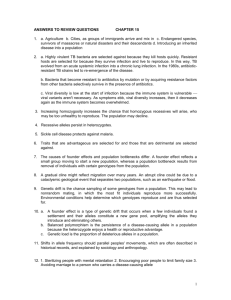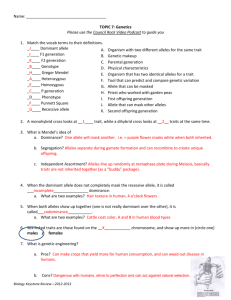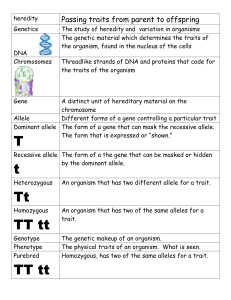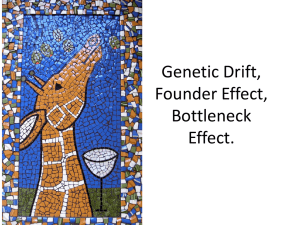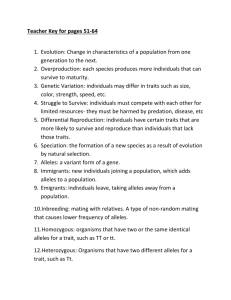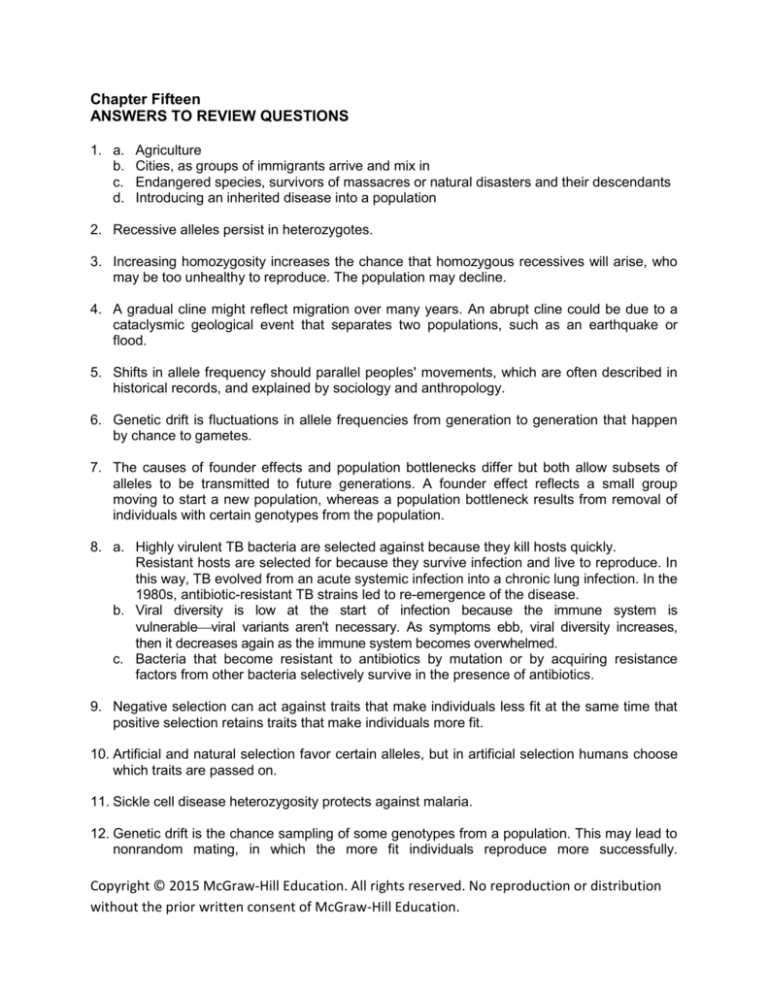
Chapter Fifteen
ANSWERS TO REVIEW QUESTIONS
1. a.
b.
c.
d.
Agriculture
Cities, as groups of immigrants arrive and mix in
Endangered species, survivors of massacres or natural disasters and their descendants
Introducing an inherited disease into a population
2. Recessive alleles persist in heterozygotes.
3. Increasing homozygosity increases the chance that homozygous recessives will arise, who
may be too unhealthy to reproduce. The population may decline.
4. A gradual cline might reflect migration over many years. An abrupt cline could be due to a
cataclysmic geological event that separates two populations, such as an earthquake or
flood.
5. Shifts in allele frequency should parallel peoples' movements, which are often described in
historical records, and explained by sociology and anthropology.
6. Genetic drift is fluctuations in allele frequencies from generation to generation that happen
by chance to gametes.
7. The causes of founder effects and population bottlenecks differ but both allow subsets of
alleles to be transmitted to future generations. A founder effect reflects a small group
moving to start a new population, whereas a population bottleneck results from removal of
individuals with certain genotypes from the population.
8. a. Highly virulent TB bacteria are selected against because they kill hosts quickly.
Resistant hosts are selected for because they survive infection and live to reproduce. In
this way, TB evolved from an acute systemic infection into a chronic lung infection. In the
1980s, antibiotic-resistant TB strains led to re-emergence of the disease.
b. Viral diversity is low at the start of infection because the immune system is
vulnerableviral variants aren't necessary. As symptoms ebb, viral diversity increases,
then it decreases again as the immune system becomes overwhelmed.
c. Bacteria that become resistant to antibiotics by mutation or by acquiring resistance
factors from other bacteria selectively survive in the presence of antibiotics.
9. Negative selection can act against traits that make individuals less fit at the same time that
positive selection retains traits that make individuals more fit.
10. Artificial and natural selection favor certain alleles, but in artificial selection humans choose
which traits are passed on.
11. Sickle cell disease heterozygosity protects against malaria.
12. Genetic drift is the chance sampling of some genotypes from a population. This may lead to
nonrandom mating, in which the more fit individuals reproduce more successfully.
Copyright © 2015 McGraw-Hill Education. All rights reserved. No reproduction or distribution
without the prior written consent of McGraw-Hill Education.
Environmental conditions help determine which genotypes reproduce and are subject to
natural selection.
13. Humans clearing land have created breeding places for the mosquitoes that carry the
malaria parasite. Climate change might alter where malaria occurs, which would select for
sickle cell heterozygotes. Over time, this might lead to increased prevalence of sickle cell
disease.
14. 1. Performing tubal ligation or vasectomy on people who have intellectual disability so that
they cannot have children. 2. Encouraging poor people to limit family size. 3. Avoiding
marriage to a person who carries a disease-causing allele.
15. With positive natural selection, allele frequencies shift in favor of those that increase fitness.
Negative selection results in the loss of deleterious alleles from a population. Positive
eugenic policies aimed to maximize the genetic contribution of those deemed acceptable or
superior while negative eugenic polices were designed to minimize the contribution of those
considered inferior. The major difference is that value to society is subjective and reflects
the societal prejudices of the eugenicist.
ANSWERS TO APPLIED QUESTIONS
1. Note: percentages may not add up to 100 because of rounding
a. 23% (5/22) blue triangles, 23% (5/22) red circles, 32% (7/22) yellow squares, 23% (5/22)
green diamonds.
b. 31% (5/16) blue triangles, 6% (1/16) red circles, 31% (5/16) yellow squares, 31% (5/16)
green diamonds
c. 40% (10/25) blue triangles, 20% (5/25) red circles, 20% (5/25) yellow squares, 20%
(5/25) green diamonds
d. 24% (5/21) blue triangles, 24% (5/21) red circles, 29% (6/21) yellow squares, 24% (5/21)
green diamonds
e. 19% (3/16) blue triangles, 31% (5/16) red circles, 19% (3/16) yellow squares, 31% (5/16)
green diamonds
2. Nonrandom mating
3. Genetic drift
4. Founder effect
5. Native Americans and xeroderma pigmentosum (see
http://www.pnas.org/content/108/51/20444.full and
http://www.pbs.org/pov/pressroom/2012/sun-kissed-premieres-on-pov.php)
6. Tasting bitter is harmfulsee whether people who can taste bitter substances are
overrepresented among people with cancer, because they may have avoided protective
vegetables. Tasting bitter is protectivesee whether people who cannot taste bitter are
overrepresented among those who have been poisoned.
Copyright © 2015 McGraw-Hill Education. All rights reserved. No reproduction or distribution
without the prior written consent of McGraw-Hill Education.
7. Natural selection at the time of plague epidemics
8. a. All modern Afrikaners with porphyria variegata descend from the same person in
whom the disorder originated.
b. Heterozygotes for cystic fibrosis and sickle cell disease resist certain infectious
diseases, maintaining the disease-causing allele in populations.
c. The Sherpa have a unique variant of the hypoxia inducible factor 2 genes that stimulates
the body to make more red blood cells in response to low oxygen.
d. The Amish have high incidences of certain inherited diseases because of consanguinity.
e. Migration patterns are responsible for the different frequencies of the galactokinase
deficiency allele across Europe.
9.
a. Population bottleneck
b. Founder effect
c. Geographical barriers and natural selection, acting over time, result in two
populations that have different variants of inherited characteristics.
d. Nonrandom mating
e. Population bottleneck
10. Genetic diversity would decrease over time under the dome.
11. The high incidence is due to extreme consanguinitynearly everyone is related to nearly
everyone else. Tracking the incidence of this condition is difficult because the symptoms
exist independently, and may be caused by environmental factors rather than genes.
12. a.
b.
c.
d.
Balanced polymorphism
Founder effect
Migration
Founder effect
13. Medical treatments permit alleles to remain in a population that natural selection would
eliminate.
14. Both will alter allele frequencies. Migration alters the genetic structure more rapidly.
15. Balanced polymorphism
16. Human migration out of Africa
Copyright © 2015 McGraw-Hill Education. All rights reserved. No reproduction or distribution
without the prior written consent of McGraw-Hill Education.
ANSWERS TO WEB ACTIVITIES
1. Example: West Nile virus associated illness is evolving. It arrived in the U.S. in New York
City in 1999 and has since spread nearly everywhere in the nation. Ebola virus disease is
spreading and changing, shown with genome sequencing.
2. PKU heterozygosity protects against toxins in grain-based foods.
3. Feeblemindedness. This was a subjective reflection of societal prejudices.
ANSWERS TO FORENSICS FOCUS
1. a. Forced sterilization
b. If a trait in one family is deemed inherited, it might be assumed to be inherited in another
family, when that might not be the case.
c. Wealthy people seeking partners among other wealthy people
d. How common the negative traits were in the general population. Whether the family
members were really related biologically. Environmental influences on the traits
considered. Evidence of family members without the negative traits who were
nonetheless criminals.
ANSWERS TO CASE STUDIES AND RESEARCH RESULTS
1. The allele is found in other populations.
2. European males settled in India. Later, Asian immigrants arrived. The male European
Indians had children with Asian Indian women.
3. No, because the intent would be to prevent suffering and not to improve the human race
through breeding.
Copyright © 2015 McGraw-Hill Education. All rights reserved. No reproduction or distribution
without the prior written consent of McGraw-Hill Education.

